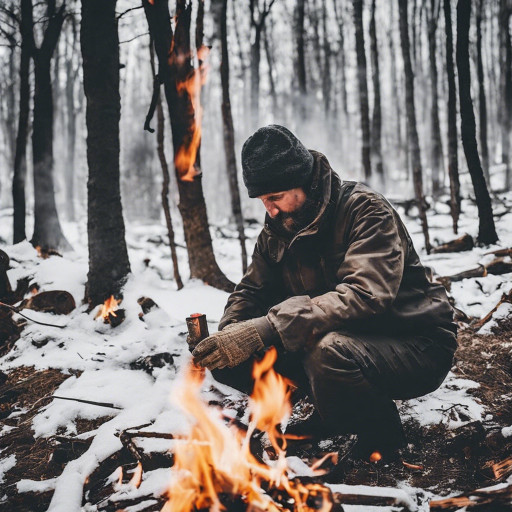Master Essential Fire Ignition Techniques for Thriving in Extreme Cold Weather
Starting a fire amidst the harsh realities of freezing temperatures is not merely a skill; it is an essential lifesaving technique crucial for survival during the relentless winter months. The frigid air, biting chill, and howling winds can make this task particularly challenging. As an experienced survivalist, you understand that a fire is indispensable—not just for warmth but also for providing light and enabling food preparation. However, igniting a fire in icy conditions poses unique challenges that require specialized techniques and strategic planning. In this comprehensive guide, we will delve into the most effective methods for successfully igniting fires in cold weather, empowering you with the skills and knowledge necessary to navigate winter’s icy grip and thrive in the wilderness.
Equip Yourself with Essential Gear: Key Supplies for Fire Starting Success
Before venturing into the winter wilderness, it is vital to arm yourself with the right gear and supplies that can significantly boost your chances of survival. A well-prepared fire-starting kit can be the key differentiator in overcoming the rigors of adverse weather conditions. Ensure your kit includes these essential items:

a. Firestarters: Reliable igniting tools such as waterproof matches, storm-resistant lighters, and fire-starting rods are essential for ensuring ignition, even in challenging conditions like wind and dampness. Having multiple ignition options at your disposal will provide the confidence and versatility you need to start a fire, no matter the obstacles that arise.
b. Dry Tinder: Finding dry tinder in freezing temperatures can be a formidable challenge. To overcome this, pack highly flammable materials like birch bark, fatwood shavings, and cotton balls soaked in petroleum jelly. These items not only ignite quickly but also dramatically enhance your chances of successfully starting a fire, especially when the mercury dips below freezing.
c. Kindling: To establish a solid foundation for your fire, gather dry sticks, twigs, and leaves. It’s crucial that these materials are completely dry; any moisture can hinder the ignition process and lead to frustration. Properly prepared kindling is vital for transitioning from tinder to a more robust fire, ensuring you can maintain warmth and cook food effectively.
d. Fuel: Securing dry firewood during cold weather can be both exhausting and time-consuming. Therefore, having a sufficient supply of dry firewood ready ahead of time is critical for maintaining a steady fire over an extended period. This preparation allows you to stay warm and comfortably prepare food without the constant worry of running out of fuel.
Select the Optimal Location for Your Fire to Boost Efficiency
When temperatures plummet, choosing the right location for your fire can offer significant advantages in terms of efficiency and safety. Look for sheltered areas, such as rock formations or dense shrubbery, to minimize exposure to biting winds. By positioning your fire near a natural windbreak, you not only reduce heat loss but also increase the likelihood of maintaining a consistent flame. Additionally, consider building a small wind-resistant shelter using logs or a tarp to shield the fire from precipitation and help retain warmth, ultimately enhancing your comfort and safety during outdoor adventures.
Utilize the Layering Technique for Sustained and Effective Fire Building
One of the most critical techniques for successfully igniting a fire in cold conditions is mastering the art of layering your materials. To build a fire that burns steadily and reliably, you must utilize three foundational layers: tinder, kindling, and fuel. Here’s an overview of each layer and its importance:
a. Tinder: The first layer, known as tinder, consists of materials that ignite quickly and easily. Utilize fine, dry substances such as grass, paper, or the aforementioned birch bark to create a robust initial flame. Having a sufficient quantity of tinder is crucial for achieving successful ignition, particularly in colder environments where conditions may be less than ideal.
b. Kindling: This layer consists of small sticks and twigs that catch fire swiftly and provide the sustained heat needed to grow your fire. Gradually add kindling to your flame, ensuring enough space between pieces to promote airflow and encourage combustion. This step is vital for transitioning from small flames to a larger, more stable fire that can keep you warm.
c. Fuel: Once a stable flame is established, gradually introduce larger pieces of firewood. Ensure that the wood is dry, as it will burn longer and generate more heat. Increase the size of the wood pieces incrementally, allowing the flames to grow stronger before adding larger logs. This strategic approach to layering your fire facilitates a stable and sustainable flame that meets your needs.
The technique of layering your fire creates a structured setup that allows the flames to expand and sustain themselves effectively. Always ensure you have an ample supply of each component readily available to facilitate a smooth transition from tinder to fuel, thereby ensuring a successful fire in challenging conditions.
Enhance Your Fire-Starting Success with Proven Aids and Techniques
In frigid weather, utilizing additional fire-starting aids can greatly enhance your chances of successfully igniting a fire against the challenges posed by low temperatures. Here are some effective methods to consider:
a. Fatwood: Often referred to as nature’s firestarter, fatwood is resin-infused pine wood that ignites easily and burns with intense heat. You can gather these naturally occurring sticks from fallen pine trees or purchase them at outdoor supply stores. A few pieces of fatwood can dramatically improve your chances of successfully starting a fire in exceptionally cold conditions.
b. Alcohol-Based Hand Sanitizer: Surprisingly effective, alcohol-based hand sanitizers are highly flammable and can serve as a powerful accelerant. A small amount applied to your tinder or kindling can help ignite a fire quickly, even in damp weather conditions. This simplification of the fire-starting process ensures you can stay warm when it matters most.
c. Char Cloth: Char cloth is a specially prepared fabric that ignites easily from sparks, making it an excellent tool for starting fires using flint and steel or a lighter in challenging situations. Its lightweight and portable nature makes it an ideal addition to your fire-starting kit, ensuring you are always prepared for whatever nature throws at you.
Incorporating these fire-starting aids into your cold-weather toolkit can significantly bolster your chances of success when facing particularly challenging conditions, allowing you to adapt effectively to your environment.
Explore Effective Fire Techniques Designed for Cold Weather Conditions
As a dedicated survivalist, continuously honing your skills is vital to your success. Here are two fire techniques that excel in cold weather conditions:
a. Swedish Torch: Commonly known as a Canadian Candle or Finnish Fire Log, the Swedish Torch is an exceptionally effective fire-starting method. This technique provides a stable and long-lasting flame, perfect for combating the chill of winter. To create a Swedish Torch, find a log about knee-height and cut several vertical slits along its length. Place tinder in these slits and ignite it. The log will serve as a consistent fuel source, allowing the flame to endure for an extended time, ensuring warmth and safety.
b. Dakota Fire Hole: When faced with strong winds, the Dakota Fire Hole method proves to be highly effective. This technique involves digging a hole and tunneling horizontally underground to create an airflow vent. This design harnesses wind to enhance airflow, resulting in a more efficient fire that is less likely to be disrupted by gusts. Moreover, the Dakota Fire Hole method effectively reduces visible smoke while conserving fuel, making it an excellent choice for stealthy fire building.
Regardless of the method you choose, always prioritize safety and responsible fire management to minimize risks and ensure a successful fire-starting experience.
Successfully igniting a fire in cold weather demands meticulous planning and execution. By adhering to these steps—preparing a reliable fire-starting kit, selecting an optimal location, mastering layering techniques, utilizing fire-starting aids, and embracing specific fire strategies—you will greatly enhance your chances of success. Remember, practice makes perfect, so consistently train to refine your skills and bolster your confidence. With these essential tactics for igniting fires in freezing conditions in your toolkit, you’ll be thoroughly prepared to face even the harshest winters that nature has in store. Stay warm, prioritize your safety, and keep the flames of survival alive!
The post Fire Starting Methods for Survivalists in Cold Weather appeared first on Survival Bite.
The Article Fire Starting Techniques for Cold Weather Survival Was Found On https://limitsofstrategy.com


10 Responses
Ah, the eternal struggle of starting a fire in frigid temperatures! It’s like attempting to get your cat to join you for a swim—most of the time, it’s just not happening. I recall a winter camping trip where my buddy and I were convinced we could start a fire with just some damp kindling and our sheer determination. Spoiler alert: we spent the evening huddled in our sleeping bags, debating the merits of investing in a good fire starter.
Your winter camping trip sounds like a classic case of underestimating nature. Damp kindling does have its charm—particularly when you’ve got the spirit of adventure driving you. But when it comes to fire, that romantic notion of sheer determination often meets cold reality.
I totally get that struggle with starting a fire in the cold. It’s like nature’s way of testing your resolve, isn’t it? I had a similar experience on a winter hike a few years back. My friend and I had all the gear, but we underestimated the dampness of the wood. We ended up improvising with lint from our pockets and some dried leaves we found. Not exactly high-tech, but it worked, and there’s something oddly satisfying about that kind of ingenuity.
It sounds like you had quite the adventure on that camping trip. Starting a fire in the cold is definitely an art form, and I can relate to the struggle. I remember a similar winter outing where I thought I could channel my inner survivalist. I had some seemingly promising kindling, but once we hit below freezing, it felt like a lost cause. We ended up huddling by a tiny embers, questioning all our life choices—like why didn’t we just bring a good fire starter?
It sounds like you’ve got a good handle on the ups and downs of winter camping! That moment when you realize your kindling isn’t going to cut it can really hit hard. I can relate to that chilly defeat too, where you’re left with nothing but a couple of stubborn embers and a heap of regrets about not preparing better.
Your insights on mastering fire ignition techniques in extreme cold really resonate with me, especially as someone who enjoys winter hiking and camping. I’ve found that preparation is truly key; I remember one particularly challenging trip where the temperatures plummeted overnight. I had packed my gear but didn’t account for the difficulty of starting a fire with damp kindling.
Ah, the art of fire starting in freezing temperatures. It’s like trying to whip cream in a blizzard—also a lesson in futility unless you have the right tools and just the right amount of persistence! I remember a certain camping trip where I thought I could channel my inner survivalist (thanks to a YouTube binge) and impress my friends with some wilderness skills. Spoiler alert: I ended up with more snow in my boots than warmth from the fire.
I can totally relate to that experience. There’s something about the thrill of trying to be a survivalist, fueled by hours of YouTube tutorials, that really gets the adrenaline pumping. I remember a hiking trip where I was convinced I could start a fire with just a couple of sticks—because, you know, if it works for Bear Grylls, it should work for me, right? Spoiler alert: it did not. I spent more time shivering and trying to scrape frost off my boots than I did enjoying the outdoors.
I totally get that feeling. There’s something captivating about the idea of being self-sufficient in the wild, isn’t there? Watching those survival shows really builds up the confidence that we can handle whatever nature throws at us. I think it’s so easy to romanticize those skills when you’re sitting on the couch, but reality definitely hits when you’re out there in the cold, trying to get a fire going.
Your insights on mastering fire ignition techniques in extreme cold weather truly resonate with me. Having spent several winters in remote camping situations, I’ve come to appreciate the delicate balance between preparation and adaptability in survival scenarios. The importance of a fire cannot be overstated; it’s not just about warmth, as you noted, but also about creating a psychological anchor that can uplift spirits in the midst of winter’s isolation.